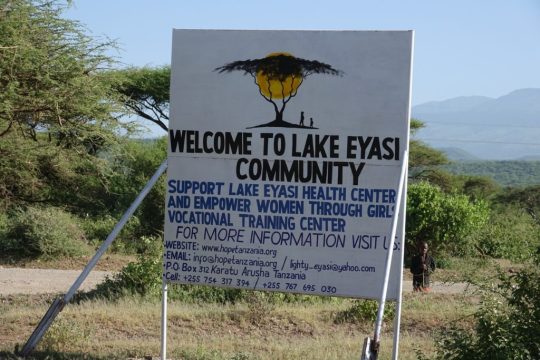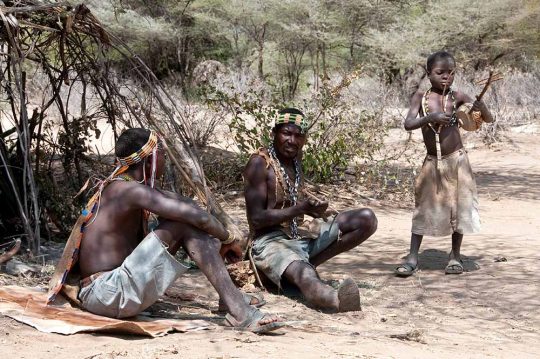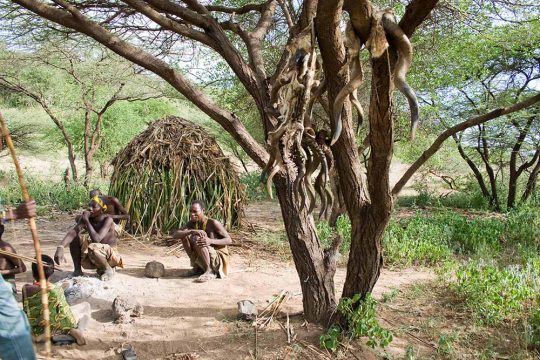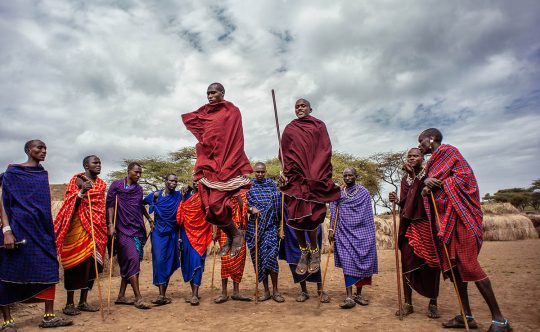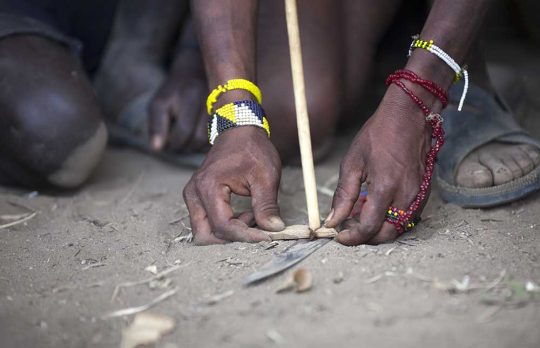Lake Eyasi
After over an one hour of dusty driving southwest of Karatu and the Ngorongoro Crater one arrives at the northern shore of Lake Eyasi, a mildly alkaline lake stretching for about 50 kilometers to the southwest.
To the northeast, the horizon is dominated by the Crater Highlands. To the north, beyond an escarpment, the plains of the Serengeti can be seen. Over 100 years ago when the stronger Maassai tribes moved into the Ngorongoro and Serengeti pushing the Datoga and other indigenous bushmen south.
Many made Lake Eyasi, the surrounding bush and forests their home.The Kisima Ngeda farm is located amongst the acacia and doom palm forests at the northeast end of the lake, by a small lava outcropping. This owes its survival to fresh water springs in the area that allow grass and vegetables to grow. The springs also sustain a small reservoir used as a small tilapia fish farm.
The farm is owned by a German family whose main source of income is fresh milk produced from the cows they keep and sold in local villages.The meadows along the shores of the lake and forest clearings by the lake provide grassy tent spaces, shower and toilet facilities.
These are made as much as possible from local materials. At night, a cool breeze keeps away mosquitos. This is an ideal place for bird-watchers or those who just want to relax a few nights in total peace.
Highlights:
- Hour Drive Southwest of Karate and the Ngorongoro Crater
- Fresh Water Springs Give Life to Kisima Ngeda Farm
- Ideal Place for Bird-watchers or Just to Relax
The Maasai People
Ever since white men came to eastern Africa, they have been having an unhappy kind of love affair with the Maasai people. Unhappy, because admiration and exasperation have been almost equally blended in the feelings towards these handsome, arrogant and stubborn tribesmen. Almost, if not quite, alone among the tribes of eastern Africa, the Masai have turned their backs upon the prizes and temptations offered by the West.The great majority of other African peoples have, after an initial period of suspicious hesitation, grasped at those offerings with both hands: at western medicine, education and, after a certain length of time, at western technology, the open sesame to that glittering go higher standard of living.
They have set their feet on the path to the consumer society. Not the Maasai. For a long time, it is true, there have been schools and hospitals in Maasai land; there are university graduates, professors, Ministers of State – even a lady who in 1970 became the first Maasai woman to graduate from Nairobi University.But by and large near years of colonial rule and attempted persuasion, followed by more than 25 years of African rule and attempted persuasion, have failed to do more than dent the fabric of custom and tradition.
Almost within sight of Nairobi’s tower blocks and traffic jams, the Maasai have continued to practice their ancient rituals and ceremonies. They have continued to maintain their age-sent structure with its warrior caste of haughty, swift and predatory Moran – storm troopers or commandos of the tribal world.
Highlights:
- Keep Their Backs Turned to Temptations of the West
- Continue to Maintain Their Age-Sent Structure
Hadzabe Bushmen
Small groups of Hadzabe bushmen live around Lake Eyasi. Their language resembles the click languages of other bushmen further south in the Kalahari. Their small population was seriously threatened, in particular during the period when Julius Nyere tried to introduce his Ujuma policy. The tribe resisted the forcible settlement policies of Julius Nyere. Nowadays most of their children have never seen a doctor or school. The bush provides for all their needs and is a class room for their offspring.
They are often willing for visitors to come and see their simple bush homes where the tree canopy alone or a cave provides them with shelter.
They live entrirely off the bush including hunting, generally small antelopes and baboons, although in rainy seasons gazelles and antelopes come down from the Ngorongoro or Serengeti to their lush bush lands offering them richer pickings. In the recent past their hunting activities were resented by trophy hunters who tried to stop their “illegal” hunting.The string on their lethal bows is made from giraffe tendons and the arrows are coated with a strong poison made from another tree. The Commiphora Tree provides excellent firewood which they kindle by rubbing the wood. A green commiphora provides a mosquito-repelling sap and the juice squeezed out of the sansaveria provides a cure for snake bites while aloe is used to heal cuts. Roots provide a wide range of medicines and the mighty baobab fruits as a source of drink. A few hours spent with the Bushmen makes the apparently unhospitable bush country come to life and to watch them hunt a unique experience as they stealthily spot then creep up on their prey skillfully killing it.
Highlights:
- Population Was Threatened
- The Bush Provides All Needs

